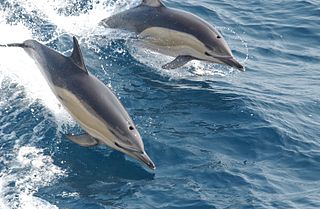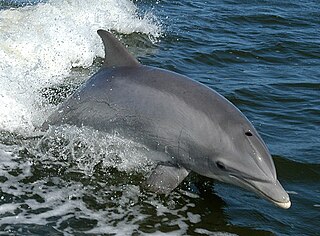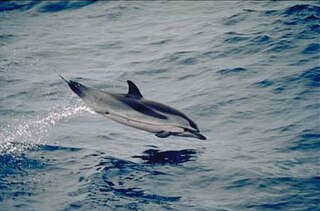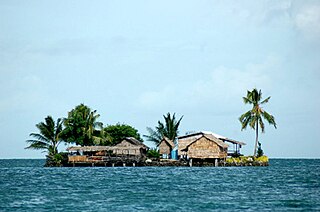Related Research Articles

A dolphin is an aquatic mammal within the infraorder Cetacea. Dolphin species belong to the families Delphinidae, Platanistidae, Iniidae, Pontoporiidae, and possibly extinct Lipotidae. There are 40 extant species named as dolphins.

Bottlenose dolphins are aquatic mammals in the genus Tursiops. They are common, cosmopolitan members of the family Delphinidae, the family of oceanic dolphins. Molecular studies show the genus contains three species: the common bottlenose dolphin, the Indo-Pacific bottlenose dolphin, and Tamanend's bottlenose dolphin. Others, like the Burrunan dolphin, may be alternately considered their own species or be subspecies of T. aduncus. Bottlenose dolphins inhabit warm and temperate seas worldwide, being found everywhere except for the Arctic and Antarctic Circle regions. Their name derives from the Latin tursio (dolphin) and truncatus for the truncated teeth.

The toothed whales are a parvorder of cetaceans that includes dolphins, porpoises, and all other whales possessing teeth, such as the beaked whales and sperm whales. 73 species of toothed whales are described. They are one of two living groups of cetaceans, the other being the baleen whales (Mysticeti), which have baleen instead of teeth. The two groups are thought to have diverged around 34 million years ago (mya).

The common dolphin is the most abundant cetacean in the world, with a global population of about six million. Despite this fact and its vernacular name, the common dolphin is not thought of as the archetypal dolphin, with that distinction belonging to the bottlenose dolphin due to its popular appearances in aquaria and the media. However, the common dolphin is often depicted in Ancient Greek and Roman art and culture, most notably in a mural painted by the Greek Minoan civilization.

The false killer whale is a species of oceanic dolphin that is the only extant representative of the genus Pseudorca. It is found in oceans worldwide but mainly in tropical regions. It was first described in 1846 as a species of porpoise based on a skull, which was revised when the first carcasses were observed in 1861. The name "false killer whale" comes from having a skull similar to the orca, or killer whale.

The Indo-Pacific bottlenose dolphin is a species of bottlenose dolphin. This dolphin grows to 2.6 m (8.5 ft) long, and weighs up to 230 kg (510 lb). It lives in the waters around India, northern Australia, South China, the Red Sea, and the eastern coast of Africa. Its back is dark grey and its belly is lighter grey or nearly white with grey spots.

The melon-headed whale, also known less commonly as the electra dolphin, little killer whale, or many-toothed blackfish, is a toothed whale of the oceanic dolphin family (Delphinidae). The common name is derived from the head shape. Melon-headed whales are widely distributed throughout deep tropical and subtropical waters worldwide, but they are rarely encountered at sea. They are found near shore mostly around oceanic islands, such as Hawaii, French Polynesia, and the Philippines.

The common bottlenose dolphin or Atlantic bottlenose dolphin is one of three species of bottlenose dolphin in the genus Tursiops. The common bottlenose dolphin is a very familiar dolphin due to the wide exposure it receives in captivity in marine parks and dolphinariums, and in movies and television programs. Spending their entire life in water, common bottlenose dolphins inhabit temperate and tropical oceans throughout the world, absent only from polar waters. While formerly known simply as the bottlenose dolphin, this term is now applied to the genus Tursiops as a whole. As considerable genetic variation has been described within this species, even between neighboring populations, many experts think additional species may be recognized.

The striped dolphin is an extensively researched dolphin found in temperate and tropical waters of all the world's oceans. It is a member of the oceanic dolphin family, Delphinidae.

A dolphinarium is an aquarium for dolphins. The dolphins are usually kept in a pool, though occasionally they may be kept in pens in the open sea, either for research or public performances. Some dolphinariums consist of one pool where dolphins perform for the public, others are part of larger parks, such as marine mammal parks, zoos or theme parks, with other animals and attractions as well.
South Malaita Island is the island at the southern tip of the larger island of Malaita in the eastern part of the Solomon Islands. It is also known as Small Malaita and Maramasike for Areare speakers and Malamweimwei for more than 80% of the islanders. The island is referred to as Iola Raha. It is called "small" to distinguish it from the much larger sibling. It is part of Malaita Province. South Malaita came under effective control of the colonial administration after the Solomon Islands was declared a British Protectorate in 1893. During the colonial days, the island was divided by the colonial government and missionary establishments into the Asimeuri, Asimae, and Raroisu'u districts.

Malaita is the primary island of Malaita Province in Solomon Islands. Malaita is the most populous island of the Solomon Islands, with a population of 161,832 as of 2021, or more than a third of the entire national population. It is also the second largest island in the country by area, after Guadalcanal.

Dolphin drive hunting, also called dolphin drive fishing, is a method of hunting dolphins and occasionally other small cetaceans by driving them together with boats, usually into a bay or onto a beach. Their escape is prevented by closing off the route to the open sea or ocean with boats and nets. Dolphins are hunted this way in several places around the world including the Solomon Islands, the Faroe Islands, Peru, and Japan, which is the most well-known practitioner of the method. In large numbers dolphins are mostly hunted for their meat; some end up in dolphinariums.

Marovo Lagoon is the largest saltwater lagoon in the world. Located in the New Georgia Islands, surrounded by Vangunu Island and Nggatokae Island, both extinct volcanic islands, at 8.48°S 158.07°E. It is part of the Solomon Islands. It encompasses 700 km2 (270 sq mi) and is protected by a double barrier reef system. Marovo Lagoon is identified as an area with high biodiversity and conservation values.

Lau Lagoon is a part of the Solomon Islands. It is located on the northeast coast of Malaita Island. The lagoon is more than 35 kilometers long and contains about 60 artificial islands built on the reef.
The Bottlenose Dolphin Research Institute (BDRI) is a research and educational centre dedicated to the understanding and conservation of cetaceans and the marine environment in which they live. The Institute's BDRI center was founded by the biologist Bruno Díaz López in Sardinia, Italy in 2005. In 2014, the BDRI opened a new facility in Galicia, Spain.
Arnarvon Islands are a group of islands in Solomon Islands. They are located in Isabel Province and nearby to Wagina Island in Choiseul Province.

The Taiji dolphin drive hunt is based on driving dolphins and other small cetaceans into a small bay where they can be killed or captured for their meat and for sale to dolphinariums. The new primary killing method is done by cutting the spinal cord of the dolphin, a method that claims to decrease the mammal's time to death. Taiji has a long connection to whaling in Japan. The 2009 documentary film The Cove drew international attention to the hunt. Taiji is the only town in Japan where drive hunting still takes place on a large scale.

The Burrunan dolphin is a proposed species of bottlenose dolphin found in parts of Victoria, Australia first described in 2011. Its exact taxonomy is debated: numerous studies support it as being a separate species within the genus Tursiops and occupying a basal position within the genus, with limited phylogenetic studies using different methodologies indicate that it is a subspecies of the Indo-Pacific bottlenose dolphin. The Burrunan dolphin is not currently recognized as a species by the Society for Marine Mammalogy or American Society of Mammalogists, which cites problematic methodology in the original study proposing species status and recommends further research.
References
- 1 2 3 Takekawa, Daisuke (2000). Hunting method and the ecological knowledge of dolphins among the Fanalei villagers of Malaita, Solomon Islands (PDF). SPC Traditional Marine Resource Management and Knowledge Information Bulletin No. 12. p. 4. Archived from the original (PDF) on 2016-03-04.
- ↑ Takekawa Daisuke & Ethel Falu (1995, 2006), Dolphin hunting in the Solomon Islands Archived 2007-09-28 at the Wayback Machine , article retrieved on June 21, 2008.
- ↑ Canadian Broadcasting Corporation TV Documentary, Doc Zone - Dolphin Dealer.
- ↑ Takekawa, Daisuke (2000). Hunting method and the ecological knowledge of dolphins among the Fanalei villagers of Malaita, Solomon Islands (PDF). SPC Traditional Marine Resource Management and Knowledge Information Bulletin No. 12. pp. 8–9. Archived from the original (PDF) on 2016-03-04.
- ↑ Kahn B., In:green, A., P. Lokani, W. Atu, P. Ramohia, P. Thomas and J. Almany (eds.) (2006). Oceanic Cetaceans and Associated Habitats. Solomon Islands Marine Assessment: Technical report of survey conducted May 13-June 17, 2004. TNC Pacific Island Countries Report No.1/06. 530.
{{cite book}}:|first1=has generic name (help)CS1 maint: multiple names: authors list (link) - ↑ "Tursiops aduncus, Ehrenberg, 1833: Solomon Islands, Delphinidae, Indian Ocean bottlenose dolphin, Indo-Pacific bottlenose dolphin". Review of Significant Trade: Species selected by the CITES Animals Committee following CoP14 and retained in the review following AC25 (PDF). CITES Project No. S-380: Prepared for the CITES Secretariat by United Nations Environment Programme World Conservation Monitoring Centre. 2012. pp. 2–10. Retrieved 20 May 2014.
- ↑ The department of fisheries and marine resources of the Solomon Islands, The Dolphin fishery in the Solomon Islands Archived July 24, 2008, at the Wayback Machine (including commentary from HSUS), article retrieved 22 June 2008.
- ↑ Solomon Times (2008), Premier Lokopio to Stop Export of Live Dolphins from Western Province, article retrieved September 3, 2009.
- ↑ Underwater Times (2009) Solomon Islands Dolphin Trade To Be Scrutinized By International Body; 'This Should Be A Wake-up Call', article retrieved July 10, 2009.
- ↑ CITES - Twenty-fourth meeting of the Animals Committee Geneva, (Switzerland), 20-24 April 2009, Review of Significant Trade in specimens of Appendix-II species, activities with regard to the population of Tursiops Aduncus of the Solomon Islands Archived July 7, 2009, at the Wayback Machine , reported retrieved September 3, 2009.
- ↑ M.Oremus et al. (2013), Population status of Indo-Pacific bottlenose dolphins, Tursiops aduncus, in the Solomon Islands and assessment of live-capture sustainability Archived December 19, 2013, at the Wayback Machine , report retrieved 19 December 2013.
- ↑ "Pacific Cetaceans MoU Membership". Convention on Migratory Species. Archived from the original on 2014-05-22.
- ↑ "Tursiops aduncus, Ehrenberg, 1833: Solomon Islands, Delphinidae, Indian Ocean Bottlenose Dolphin, Indo-Pacific Bottlenose Dolphin". Review of Significant Trade: Species selected by the CITES Animals Committee following CoP14 and retained in the review following AC25 (PDF). CITES Project No. S-380: Prepared for the CITES Secretariat by United Nations Environment Programme World Conservation Monitoring Centre. 2012. p. 11. Retrieved 20 May 2014.
- ↑ Nandini Mitra, Maureen (25 January 2013). "Solomon Islands' Dolphin Kill Spurred by Corrupt Dolphin Traders, Says Animal Rights Group". .earthisland.org. Retrieved 22 May 2014.
- ↑ "350 plus dolphins caught, slaughtered in Solomon Islands". Island Business from Solomon Star/Pacnews. 18 February 2014. Archived from the original on 22 May 2014. Retrieved 22 May 2014.
- 1 2 3 Agence France-Presse (7 May 2015). "Solomon Islanders kill more than 1,600 dolphins for their teeth". The Guardian. Retrieved 7 May 2015.
- ↑ Inifiri, Jeremy (17 February 2014). "Solomon's PM Defends Traditional Dolphin Hunting: Lilo supports seasonal 'harvesting,' opposes export of live dolphins". Solomon Star.
- ↑ Reuters (2003), Plane Arrives to Carry Captured Solomons Dolphins Archived 2006-05-11 at the Wayback Machine , article retrieved on June 21, 2008.
- ↑ Supplement to the Solomon Islands Gazette, dated Thursday the 25th of November 2005; The fisheries (prohibition of export of dolphins) regulation 2005, retrieved October 14, 2006.
- ↑ The Associated Press / International Herald Tribune Solomon Islands dolphins exported to Dubai; protests mount, article retrieved June 21, 2008.
- ↑ Moffat Mamu for Solomon Star News (2010), Berman welcomes release of dolphins Archived 2011-06-14 at the Wayback Machine , article retrieved February 13, 2010.
- ↑ SBS World News (14 July 2015) Solomon Islanders on collision course with authorities over dolphin hunting